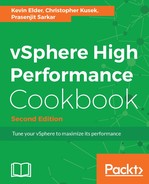Let's look at the different types of disks:
- Eager zeroed thick: Disk space is allocated and zeroed out at the time of creation. Although this extends the time it takes to create the disk, using this disk type results in more consistent performance, even the first time we write to each block. The primary use of this disk type is for quorum drives in an MSCS cluster. You can create eager zeroed thick disks on the Command Prompt with vmkfstools. As per VMware, there is no statistical difference between eager or lazy once all the blocks have been zeroed. It is the zeroing process that creates an inconsistent performance on the lazy filesystem, and this is where eager benefits.
- Lazy zeroed thick: Disk space is allocated at the time of creation, but each block is zeroed only on the first write. This disk type results in shorter creation time but reduced performance the first time a block is written to the disk. Subsequent writes, however, have the same performance as an eager zeroed thick disk. This disk type is the default type used to create virtual disks using vSphere Client and is good for most cases.
- Thin: Disk space is allocated and zeroed upon demand, instead of upon creation. Using this disk type results in a shorter creation time but reduced performance the first time a block is written to the disk. Subsequent writes have the same performance as an eager zeroed thick disk. Use this disk type when space usage is the main concern of all types of applications.
Thin and lazy zeroed thick disks deliver virtually the same performance. It's the writing zeros, not the allocation, that is expensive. Only eager zeroed provides any real performance improvement. And even that is usually not tremendous. There's a really good white paper on this at http://www.vmware.com/pdf/vsp_4_thinprov_perf.pdf.
